7 Best Violin Scale Books
Improve your violin technique with scales!
Practicing scales is great to improve your intonation, bowing technique, confidence on the fingerboard and violin playing in general
Like Itzhak Perlman points out in his masterclass I followed, scales should be part of your daily practice routine to get to know the fingerboard and play in tune confidently. When Heifetz tested him at the age of fourteen, he had to play scales to really test his violin technique.
Music is made out of scales
If you have scales, arpeggios and double stops in your fingers, it will take so much less time to practice a new piece of music. You can focus on expression and musicality much earlier without getting lost in the technique.
What scales should you practice?
According to Itzhak Perlman’s practice schedule, you spend around a third of your practice time on scales.
Each day you can:
- Practice a different scale each day to maintain and improve your technique in general.
- Pick a particular exercise, like scales in octaves, and play them in each key.
- Do various exercises in the key that matches the piece you’re currently playing.
- Apply different bowing techniques to (for example) a three octave scale.
This all depends on your level of playing and what you want to improve on right now. Never practice scales mindlessly. Always have a clear goal in mind and correct yourself like you’re your own teacher standing in the room.
Beginner to Intermediate Violin Scale Books
When you’re new to the violin, complete advanced scale books like I mention later in this article, might be very intimidating.
As a beginner or intermediate violinist, you might want to look into a scale book that’s more of a curriculum and tells you exactly what to start with and which scale to practice next. You want a scale book in order of difficulty.
Sensational Scales
Please forgive me for tooting my own horn, but I’d like to start with my own free violin scale book Sensational Scales. Not because I have the arrogance of thinking it’s the best (don’t worry, I don’t). I just to give you a free possibility right away to get you started with violin scales today.
With my students I’ve always missed a book that takes them from first scales in the first position to all three octave scales and beyond. Easy scale books were too easy, but complete scale books like you see later in this article were too difficult and intimidating.
I wrote a scale book that is based on sequence of finger patterns you learn in the first years of violin playing
In this way the scales will match the method book you’re working from and will feel logical to you.
In the book I’ve included fingerboard maps for each scale that show you exactly where to find the notes in the violin
In that way you never have to guess if it’s a large or small distance.
After this book you can move up to a complete scale method like the ones described below.
The best part about my scale book is that it’s FREE. Click here to download the PDF.
FREE Violin Scale Book
Sensational Scales is a 85 page violin scale book that goes from simple beginner scales with finger charts all the way to all three octave scales and arpeggios
Serrano – Learn Music Theory & Violin Scales
A Fun & Comprehensive Approach To Learning Theory & Violin Scales
If you’re looking for a violin scale book that not only gives you the sheet music for all the violin scales, but also teaches you about music theory, this book ‘Learn music theory and violin scales’ by Amy Serrano is the best book I can recommend.
It’s very easy to understand and shows you finger charts, circle of fifths and all the violin notes in the scales. You learn exactly what the different scales are and the distances between the notes. At the same time you’ll really understand scales, chords, keys and arpeggios. It goes up to three octave scales, so this book can guide you on your violin journey for many years.
A cool thing is that she not only covers major and minor, but also goes into ‘sassy scales’ like blues scales, which is great for violin players of today who not only play classical music. Click here to buy!
Hrimaly – Scale-Studies for the Violin
This is also an accessible scale book to start out with. It’s categorized per exercise and shows them in all keys. In this way it’s different from Sensational Scales, which works from the finger pattern sequence you learn.
This book teaches you up to three octave major scales and prepares you very well for these throughout the book. I also like the great number of bowing variations this book offers.
The downside of this book is that it starts with very simple exercises, but it gives them in all keys. As a beginner you must be able to judge which keys you can play with the finger patterns you’ve learned. Also you don’t know for sure if you’re playing the right notes, as there are no fingerboard maps.
This is a great book if you’re working with a private teacher and he/she can guide you by pointing out the scales you should practice and correct you along the way.
Click here to get the Hrimaly violin scale book.
Advanced Complete Violin Scale Books
When you’ve worked through your first scale book and know how to play in different keys and positions, it’s time to get yourself a complete violin scale book.
For the rest of your life you’ll have a love-hate relationship with this book.
Flesch – Scale System
This is the book I grew up with. It’s very complete and organized per key. You can pick for example the key of the piece you play and do all kinds of scale exercises in it.
It starts with one octave scales, arpeggios and broken thirds in one octave on one string. After that the same in three octaves on multiple strings (I love the fingering), thirds, sixths, octaves, fingered octaves, tenth’s, harmonics and double stops in harmonics.
The only downside might be that there are not much bowing and rhythm variations, but I was always used that my teacher gave me assignments about this.
Click here to buy the Flesch violin scale book in the edition I recommend.
Galamian – Contemporary Violin Technique
A very complete scale method that I can warmly recommend!
Volume 1 includes scales organized per exercise. So each exercise (like scales on one string) is given in each key. Flesch is organized per key and gives all exercises in that key. It depends on your practice strategy what you like best. Of course it’s handy to have both variations, so you can do both.
Good thing is that this book also includes the four octave scales!
The book includes an insert with bowing and rhythm patterns that you can apply to the scales. Very useful!
Volume 2 is focussed on double and multiple stops in scale and arpeggio exercises.
I recommend buying both volumes including the bowing and rhythm patterns. Click here to buy volume 1 and here to buy volume 2.
Sevcik – Scales and arpeggios
Just as Galamian this book is organized per exercise and gives this exercise in all keys. It walks you through the positions with specific scale exercises for each position. Sevcik includes bowing patterns throughout the exercises, so you don’t have to look them up separately.
I know a lot of accomplished violinists who grew up with Sevcik instead of Flesch. This can differ per country. I’d say you play the same things in both, but the difference is that you can either do all exercises in one key (Flesch) or do one exercises in all keys (Sevcik).
Sevcik is organized in a clear way and you can easily find the exercise or position you’re looking for.
Click here to buy the Sevcik violin scale book.
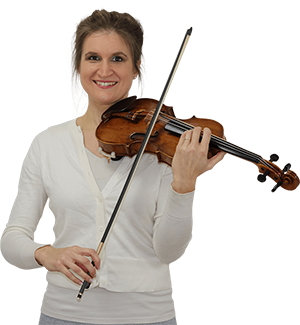
Hi! I'm Zlata
Classical violinist helping you overcome technical struggles and play with feeling by improving your bow technique.
Schradieck – School of Violin Technics
This is a great bundle of the three violin technique books by Schradieck and his scale studies book.
Book one gives dexterity exercises in various postions, which are great to improve the confidence, speed and flexibility of your left hand. Really helpful!
Book two gives exercises in double stops. Practicing double stops is so great for your intonation and left hand technique in general.
Book three is all about bowing exercises.
The three books total 100 pages of great violin technique exercises. You might want to get these in addition to one of the above scale books.
After the three books you’ll find a full scale book. It’s good, but not so comprehensive as the three books mentioned above.
With this bundle you’ll have a complete encyclopedia of violin technique. As the scale book is a bit limited I recommend getting this bundle as an addition to one of the three books mentioned above.
Click here to buy the Schradieck bundle.
What violin scale book do you use?
Do you practice scales on a daily basis? Let me know in the comments below what book you use and what your scale practice strategy is at the moment.
Being grown up with Flesch and used to practicing lots of things in one keys a day, now I’m using Sevcik to become more flexible in changing between keys. There were times I practiced scales for almost two hours a day, but to be fair those days are gone, haha! I use scales a (almost) daily warm up at the moment.

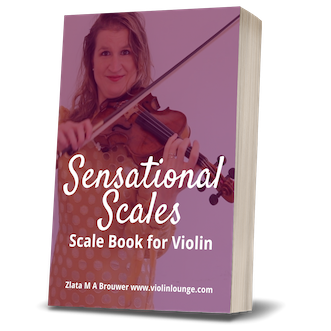
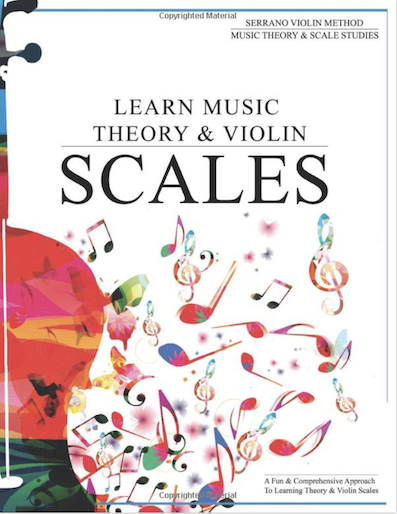
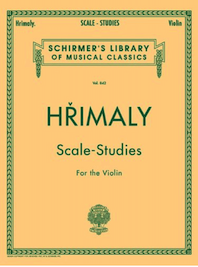
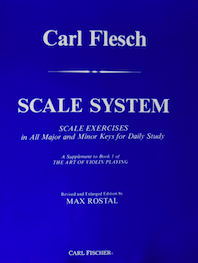
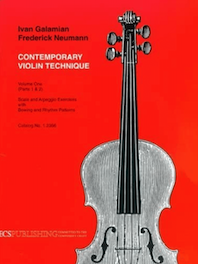
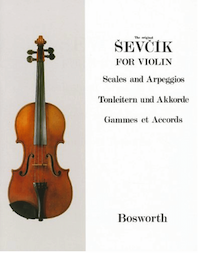
I play the viola. Any book on scales you can recommend?
Sure, Flesch for example is also available for the viola!
I can’t thank you enough for this!
And yes I do practice them every time.
Good work, Ruba!
Hello Zlata,
Thank you for freely sharing your expertise and guidance The following scale books are for the violin first position.
My very basic scale book is Scales for the Violin by Samuel Flor which covers all 24 scales (major and melodic minor) and arpeggios
Another that I have used is A Beginning Scale book by C Paul Herfurth and includes studies in thirds, arprggios and an introduction to Double Stops.
Two others for violin are by Samuel Applebaum: Scales for Strings Book 1 and 2 with plenty of exercises and cover major and all three minors up to 3 sharps and 3 flats.
Hope this helps at the beginner level.
Thanks for sharing, Stewart, I’m sure those are useful books for beginner or intermediate players. What pieces are you working on right now?
Hello Zlata,
My aim is to get all scales Major and Minor (all 3) up to and including 4 sharps and 4 flats in two octaves. Nearly there.
Just about to complete, as above requirements, Leopold Auer’s Graded Course in Violin Playing Book 4.
Then onto Preparing for Kreutzer Book 1 by Harvey S Whistler and repeating the Scales using Essentials for Strings (KJOS) and Bytovetski Scale Technic for the violin.
Looking to feel really confident in first position so that I can ‘hear and feel’ the tones in all of those key signatures before moving onto third position since then I have an ‘audio’ and ‘tactile’ memory with which to double check my intonation.
I have last year completed Kuchler’s Concertino in D Major just to feel and hear it and to see if I was capable (at 73) ! ( A bit late in life )
Hi Stewart, sounds that you’ve found some very good books to study by yourself! In the Violin Lounge Academy I’ve got a course Sensational Scales teaching scales from the absolute beginning up to all three octave major and minor scales. You might find it interesting. Congrats on your patience of not wanting to go too fast into position playing. To get a good foundation will save you a lot of time and frustration in the future :). Keep on going!
What is the easiest scale book for violin on one to third position to daily practices
I’d say go for one of the first two books described in this article.
I use Simon Fischer’s book. You don’t mention this, I think. Unless I missed it
I haven’t looked into it extensively (I’m too much in the 19th century I guess), but in general the work of Simon Fischer is great and thorough, so no doubt his scale book also is. Thank you for mentioning!
I studied Flesch on the viola when I was 16. Now, I’m studying with Schradieck.
Impatient to try your recommendations!
Thanks for sharing!
Thank you so much
You’re welcome, Marina!
How about “A Tune a Day” scale book? it covers the basics too, and is a compliment to the main series of beginner lessons. but it’s onlynin 1st position, very well done. i’ve used it and liked it.
Thanks for sharing!
I am an adult learner at 71 years of age and know the major and minor scales through piano. I have been playing a little over 9 months. I play scales because I know the scales already, I have been playing without a scale book. I know my teacher intends for me to have a scale book, but she has yet to give me one or have me purchase a particular book. I am in the Stringbuilder book 2. I am still working on my bowing to get a beautiful sound, but am making progress. I am capable of figuring out any scale, because I understand and can hear the pattern, but would love the ability to read and move up the strings as needed. Which of the 6 scale books might fit with me since one octave scales would not be much of a challenge for me.
I would go for Serrano’s and/or mine.